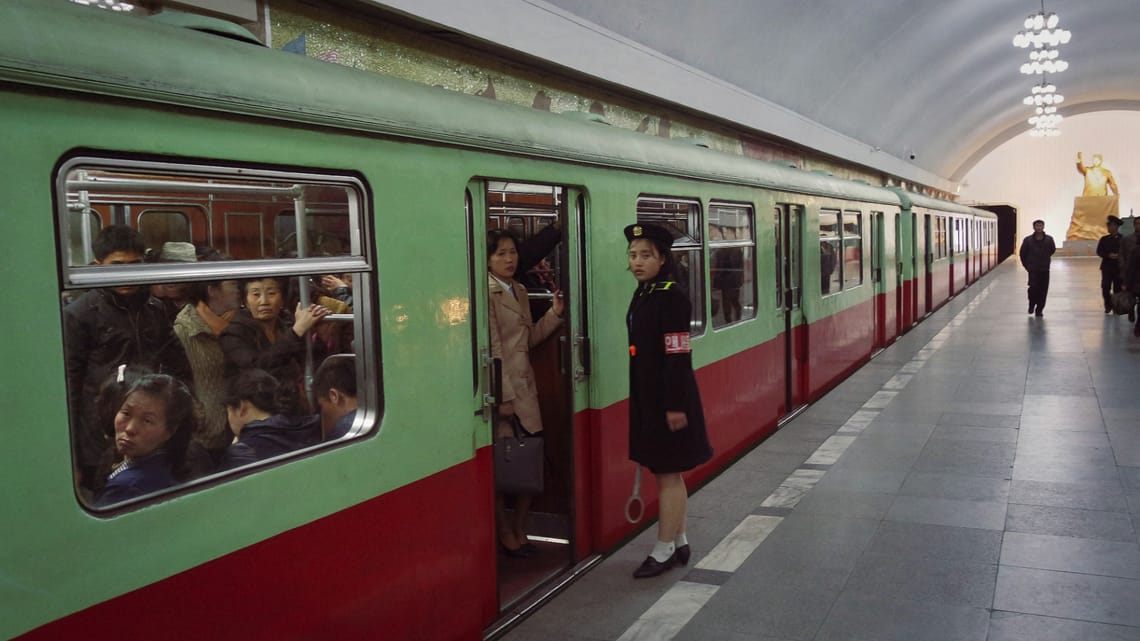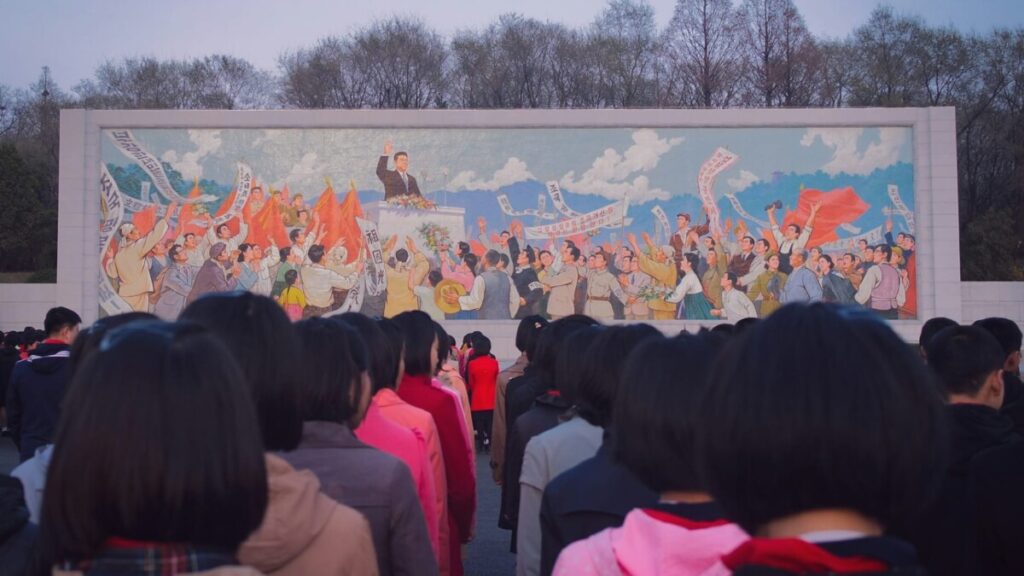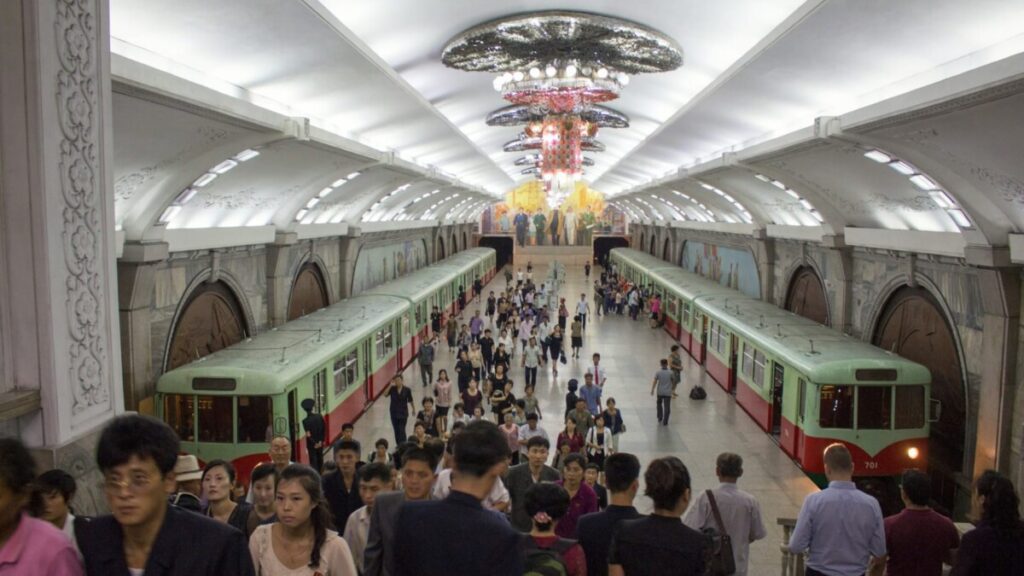Inside the prison state
Feature: What’s it like to live in North Korea? Yumi Kim on heavy repression, secret phone calls, and virtual private networks.

The Korean Central News Agency, Pyongyang’s official broadcaster, released footage in July of families riding dune buggies along a beach, playing arcade games, sliding down brightly colored water slides. They were visiting Wonsan Kalma, a coastal resort where Supreme Leader Kim Jong Un had cut the ribbon weeks earlier. KCNA described 680 tourist attractions, dozens of hotels, and millions of tons of healing mud.
Most of North Korea’s 26 million people will only ever see Wonsan Kalma on their screens. It’s a showpiece in Kim’s campaign to attract foreign investment and project an image of prosperity—built for the well-connected in a country where people aren’t free to move about and couldn’t afford to visit a beach resort even if they were.
Behind the bright footage: forced labor and the mass displacement of neighboring residents. At least that’s what defectors who’ve escaped say. But getting reliable information about what actually happens inside North Korea has always been difficult—a closed system reporting on itself. Since the pandemic, it’s become harder still. Defector numbers have dropped steeply. The main sources of information are still what they’ve always been: defector accounts, tightly controlled junkets for foreigners, and the regime’s own propaganda machinery.
So what’s life actually like there? And is anything changing?
Yumi Kim is a defector from Haeju, North Korea, who escaped with her family to the South by boat in 2023. A Korean People’s Navy vessel chased them through the night. They only got away when fishing nets they’d thrown overboard tangled in the pursuing ship’s rudder.
Since Kim Jong Un came to power, she says, North Korea’s totalitarian system of repression has only intensified—with stronger surveillance, a wider network of informants, tighter control over daily life. The government cracks down on anyone caught with outside media using wiretaps, warrantless searches, beatings, show trials, and executions.
But there’s something else happening too—something the regime might not be able to stop. Younger generations are pushing back. They smuggle in flash drives from across the Chinese border. They make illegal cross-border phone calls. They secretly watch South Korean shows and movies on devices hidden from the authorities. North Korea’s Gen Z—raised on propaganda but exposed to glimpses of the outside world—thinks differently than their parents did. They ask different questions. They resist in small ways that might, over time, add up to something bigger.
Whether that skepticism—or Kim Jong Un’s expressed desire for foreign investment and his showpiece resorts—can change anything in a system that’s been dedicated to resisting change for seven decades just isn’t clear. What is, meanwhile: The gap between the propaganda footage and the reality keeps spreading …
Barbara Frye: Here in The Signal, Michael Breen talks about how difficult it is to know what’s going on inside North Korea—but also says there are signs that Kim Jong Un has begun to focus much more on the country’s economy. For instance, at least two factories were under construction in each of the country’s provinces last year. Have you seen supporting or contrary evidence from inside the country?

Yumi Kim: This economic development began after I left North Korea. But the North Korean people are still suffering. When the government opens a new construction site or starts a new tourism project, citizens are ultimately responsible for the project. Every new project means another burden for North Koreans.
The state provides very limited support—so it issues orders for mobilization and contribution, or po-chi. It’s like subcontracting in the West, except the subcontractors are regular citizens, businesses, neighborhood units, and even students.
For example, when the government launched the Samjiyon city construction project—one of the largest development plans in the country’s history, including railways and an airport—every unit received po-chi assignments. That included businesses, students, and even neighborhood watch groups. The message was that the state was undertaking a difficult construction project, so everyone had to contribute. People and organizations had no choice but to fulfill the order, often including labor at the site.
The government provides some resources, but most construction is financed by extracting money from the public and forcing people to contribute labor.
In the po-chi system, state authorities assign financial or material quotas to lower-level units, whether enterprises or local organizations. An order might say, This unit is tasked with completing a housing project this year. You must procure 20 million won worth of building materials. That quota is then passed down, and anyone receiving it is obliged to carry it out.
Most North Koreans don’t really care about the party’s pronouncements. They don’t have the time or energy to react because they’re trying to survive.
These public units impose the tasks on those below them: workers, members of the women’s union, students. Essentially, anyone capable of holding a spoon is assigned a quota. Contributions are collected relentlessly, and the authorities press people day after day to comply.
They say it’s an investment for the future and the economy, but it’s built on the sacrifices of North Koreans—and it doesn’t improve their daily lives. Cultural and tourism projects—regular people can’t enjoy those facilities, even though they built them. They can’t just spend a weekend there. Maybe foreigners or some high-level political elites might enjoy them, but not normal citizens.
Frye: In late 2023, Kim Jong Un announced the North was no longer interested in reunification with the South—and Pyongyang now saw Seoul as its main enemy. What changes did you experience in how the North Korean government portrays South Korea—and how North Korean people think about it?
Kim: In North Korea, we used to be told that all Koreans were the same people, from the same country, and we would be unified at some point. And even though the North Korean state criticized South Korea because of the difference in political systems, there was an underlying notion that we would have to unify sometime.
But when Kim Jong Un came to power, descriptions of South Korea became more aggressive and hostile. For example, when South Korea conducted military exercises with the U.S., the regime called South Korea an aggressor against North Korea and a country we had to be on guard against—and that included the people of South Korea. The Kim Jong Un regime has forbidden North Koreans from talking about unification.

Frye: So how do most people in North Korea see the South?
Kim: Most North Koreans don’t really care about the party’s pronouncements. They don’t have the time or energy to react because they’re trying to survive. Still, there are a few people who truly believe the party propaganda and think of South Korea as an enemy—but most people still see South Korea as a wealthy country where, unlike in North Korea, people aren’t hungry.
Frye: Is there a generational difference? Do older people see the relationship with South Korea differently than younger people do?
Kim: The older generation grew up with that unification propaganda and, especially in the 1940s and 1950s, they tended to accept it more readily. However, there’s a big difference between the overall perceptions of the older generation and Gen Z in North Korea, because younger generations get information from the outside world more easily than the older generation does. Their way of thinking is very different.
For example, there’s a censorship department in North Korea, and the older generation and Gen Z react to it very differently. The older generations were raised with censorship, so when they hear the censorship department is going to check on them, they get nervous—that fear is ingrained in them.
You might be watching South Korean TV shows or YouTube videos, but this isn’t just entertainment—it’s also a way to change how people think.
But Gen Z has access to lots of outside information and watches lots of South Korean TV shows and media, so they react differently when they hear the censorship department is going to come and check whether they’ve been watching South Korean TV. They start asking questions and demand to see a search warrant. They don’t take government censorship as inevitable or justified.
Frye: In an address to the Oslo Freedom Forum, you said more outside information was getting into North Korea. How is that happening? And what do you think it means for the country?
Kim: In the past, it was impossible to get outside information into North Korea, and it was very difficult to see South Korean media. But these days, information gets in through all sorts of ways. USB flash drives are smuggled across the Chinese border, or activists in South Korea stuff USB drives into plastic bottles filled with rice and put them into the sea. I lived near the coast in North Korea, and I saw some of them wash ashore.
In recent years, lots of people have been going to the area around the Chinese border and using their phones to message or call someone outside the country—that’s illegal and very risky, but it shows people increasingly want to be connected to the outside world.
You might be watching South Korean TV shows or YouTube videos, but this isn’t just entertainment—it’s also a way to change how people think. The North Korean government has brainwashed its people to believe that the outside world is hell and North Korea is the best place ever, but people are seeing life in the outside world via these media, and they’re questioning that propaganda.

They’re starting to ask why they have to live like this when the outside world is so wealthy. It naturally leads to more complaints and also questions about the North Korean regime and the system they live under. I would say that information is the seed of freedom.
Frye: You have a YouTube channel about life in North Korea today. How do you get information from people there?
Kim: I watch the Korean Central News Agency channel, which you can only access in South Korea via a virtual private network. But with a VPN, you can easily access North Korean websites from South Korea as well. I also know some people who still have connections in North Korea, like friends or relatives. And, as I said, it’s possible to have a phone call or even a video call with people who live in the border area, though you need a go-between to arrange a phone call.
Frye: Most people know North Korea as a deeply repressive state with internal political prisoners and extensive forced labor. Have you seen any changes over time in the state’s apparatus for political repression?
Kim: I would say there’s been a change in enforcement methods, but the core of the system hasn’t changed. Before Kim Jong Un, there were show trials or executions to instill fear. They still exist, but the authorities have also started a monitoring and informant system to sow distrust among the people.
When the state orders you to construct a new factory or build a new road, there’s no option to say no.
Living in this environment—where you don’t know who’s monitoring you and who’s going to inform on you—is a form of suppressing the people. Political prisoners and the camps still exist, and normal people still have to do forced labor for the state. When the state orders you to construct a new factory or build a new road, there’s no option to say no.
Frye: Is it new that neighbors inform on each other to the authorities?
Kim: Before Kim Jong Un, there was a snitching system too, but it was more of a formality. But nowadays it’s started to directly affect the people.
Before, security officers recruited spies and gave them orders to gather information, and then the officers would conduct some kind of operation based on that—but this was relatively rare. When Kim Jong Un came to power, those security officers needed to show their worth to the party, so they could keep their jobs. So they started to aggressively recruit potential spies—smart citizens willing to cooperate with them.
As I said, North Korean citizens are banned from watching South Korean media, but spies were allowed to watch—and even encouraged to disseminate South Korean media to people to entrap them. They help arrest their own friends and neighbors to show their bosses that they’re contributing to the system. That’s increased under Kim Jong Un.
There was also a big increase in forced labor, which is called “the voluntary mobilization of labor force.”

Selling North Korean workers to foreign countries also existed before, but it was difficult to send people to China or to Russia. But under Kim Jong Un, people are sent to China and Russia en masse. They’re sent to restaurants, factories, and even for domestic work, like au pairs, and they have to work 12 to 14 hours a day, but their pay goes to the North Korean regime. Individual workers abroad get the bare minimum to survive, while the government takes most of their pay.
Lots of women are sent abroad, and they’re highly vulnerable to sexual abuse—but they don’t really have any protection, even though they have North Korean officers there to monitor them. And even when they’re sick, they can’t go to the hospital or seek protection.
Frye: If you’re not a member of the elite in North Korea, can you even choose your job?
Kim: No, in North Korea, you can’t choose your own job. There is a Ministry of Labor, and they assign it to you.
North Koreans can choose three paths: go to university, join the military, or join a labor brigade, where they’ll dispatch you to a construction project or something similar. Otherwise, the ministry will assign you a job.
Frye: You defected in 2023, making you one of the most recent defectors to speak publicly about your experience. What are the most significant ways you saw the country changing?
Kim: I think the biggest difference is that people’s minds are changing. Before, people would just accept whatever the government said. But now, people question what the government is telling them, even though they keep it to themselves. With the outside information they’re getting, in their minds, they’re waking up.
- Inside the prison state - November 3, 2025

